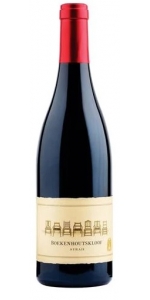Wine from Boekenhoutskloof
Boekenhoutskloof was established in 1776. Located in the furthest corner of the beautiful Franschhoek valley, the farm’s name means “ravine of the Boekenhout” (pronounced Book-n-Howed). Boekenhout is an indigenous Cape Beech tree greatly prized for furniture making.
In 1993 the farm and homestead was bought and restored and a new vineyard planting programme was established that now includes Syrah, Cabernet Sauvignon, Cabernet Franc, Grenache, Semillon and Viognier.
As a producer, Boekenhoutskloof is a Syrah specialist, with its premium Boekenhoutskloof range selling out on release each vintage, and The Chocolate Block – a Syrah based blend – is probably the most successful new wine offering to come out of South Africa in the modern era.
The Wolftrap brand of blended Rhone-style wines was inspired by the pioneering spirit of the early settlers who built what is now a monument to their adventurous spirit. The Porcupine Ridge range of delicious, everyday wines is a firm favourite on tables throughout the world – offering great value and superb drinking.
Boekenhout is an indigenous Cape Beech tree greatly prized for making fine furniture. Our Boekenhoutskloof label features seven chairs; amongst them the country-style split splat chair made in the neo-classical style with a shouldered top rail and thonged seat from the late 18th century.
Then there’s the Sandveld chair that has two back rails and a thonged seat which made its appearance in the second quarter of the 19th century. The transitional Tulbagh chair was made in the late 18th century, it has a plain back and a shaped top rail with half-round opening.
The chairs on our wine label all pay tribute to the skills of the 18th century craftsmen and their achievements in creating beauty from natural sources, just like the pursuit of fine wine-making.
Boekenhoutskloof Syrah Swartland is made from 100 percent Syrah.
Grapes for our Boekenhoutskloof Syrah are picked from selected parcels of the finest Syrah, grown at our Swartland farms, namely Porseleinberg and Goldmine, close to the small town of Riebeek-Kasteel. These vineyards were planted on the rocky bedrock of decomposed Mica-Schist, a unique terroir, finding its expression in our concentrated and structured wines made from this Rhône grape.
The nose is perfumed, forthcoming and fresh, offering an array of rich dark fruits with a spicy, floral, even feral character, derived from complex aromas of dark berries, plums, violets, black olives, star anise and potting soil. The black fruits and earthy character of the nose follow through onto a dark, brooding palate with flavours of wild berries, brambles, liquorice, tobacco, cloves and black cardamom. The mid-palate is concentrated, deep, dense and slightly dusty, with dry, very fine cocoa-powdery tannins lending structure. The wine is very precise, with a medium to full body, a tight, grainy texture and vibrant acidity to balance. Blackberries, blueberries and notes of garrigue and dark chocolate linger on a savoury finish.
Review:
Using fruit from two exceptional Swartland sources – Goldmine and mostly Porseleinberg – this foudre-aged Syrah is fresh, subtle and intensely aromatic, as schist Syrahs often tend to be. Complex, floral and refined with remarkable freshness and palate length. Drink: 2020-2028.
– Tim Atkin MW, 95/100
- back
Selected Options
Wineries
Categories
Pricing
Countries
Regions
Grape Types
Wineries
Organic/Free Shipping
All older vintage wines have been purchased from a single collectors cellar. Pictures can be requested before shipment.
100% apple wine. A blend of Golden Delicious and Fuji apples hand-picked in the Shenandoah Valley; aromas and flavors of freshly harvested apples, blossoms and spices. (semisweet)





